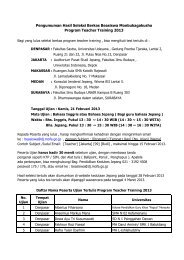9700_y16_sy
9700_y16_sy
9700_y16_sy
Create successful ePaper yourself
Turn your PDF publications into a flip-book with our unique Google optimized e-Paper software.
Cambridge International AS and A Level Biology <strong>9700</strong> <strong>sy</strong>llabus Practical assessment<br />
• Include a simple risk assessment of their plan, identifying the areas where an accident or injury is most<br />
likely to happen and the areas where it would be most serious<br />
• Describe the precautions that would need to be taken to minimise risks where possible. These<br />
precautions should be specifically related to the risks they have identified, for example soda lime used to<br />
absorb carbon dioxide is corrosive and poses a particular risk if it comes in to contact with the skin and<br />
cornea, so wearing gloves and eye protection would be an appropriate precaution.<br />
Analysis, conclusions and evaluation<br />
Analysis, conclusions and evaluation tests the ability of candidates to process given data in a variety of<br />
ways.<br />
These marks are awarded for three strands of skills:<br />
• Dealing with data<br />
• Evaluation<br />
• Conclusions.<br />
Dealing with data<br />
Knowledge of the Mathematical requirements in Section 5.1 of the <strong>sy</strong>llabus is expected.<br />
From provided data, candidates should be able to:<br />
• Decide which calculations are necessary in order to draw conclusions, including considering the use of:<br />
– error levels<br />
– confidence limits<br />
– statistical tests<br />
• Use tables and graphs to identify the key points in quantitative data, including the variability of data<br />
• Sketch or draw suitable graphs displaying the independent variable on the x-axis and the dependent<br />
variable on the y-axis, including confidence limit error bars, calculated using standard error<br />
• Choose appropriate calculations to simplify or explain data<br />
• Carry out calculations in order to simplify or compare data<br />
These calculations may include:<br />
– percentage and percentage gain or loss<br />
– rate of change<br />
– species diversity index<br />
– estimation of population size<br />
• Use values of standard deviation or standard error, or graphs with standard error bars, to determine<br />
whether differences in mean values are likely to be statistically significant<br />
• Choose statistical tests appropriate to the type of data collected and justify use of these tests<br />
• State a null hypothesis for a statistical test<br />
• Apply statistical methods in order to assess variability in data. These methods may include:<br />
– Use of descriptive statistics statistical tests to assess the variability of data or the statistical<br />
differences between samples, including t-test, chi-squared test, Pearson’s linear correlation and<br />
Spearman’s rank correlation<br />
– Calculate the degrees of freedom for a statistical test<br />
– Use a probability table to determine the significance of a calculated value for the t-test and the<br />
chi-squared test<br />
• Recognise the different types of variable and the different types of data presented.<br />
Back to contents page<br />
www.cie.org.uk/alevel<br />
67





